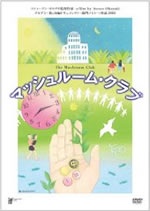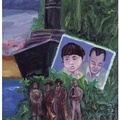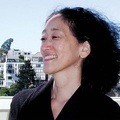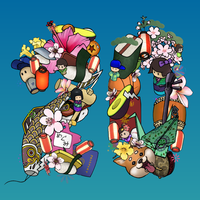>>Part 1
Another person who left a strong impression on me in "Hiroshima Nagasaki" was Sumiteru Taniguchi. While he was giving his testimony, he suddenly took off his clothes and started exposing his injured body to the camera. When Taniguchi was 16 years old, his entire back was burned in the atomic bombing, and he spent a year and nine months lying face down. As a result, his chest developed bed sores, exposing his ribs and turning brown. According to Okazaki, Taniguchi's sudden actions were completely unplanned.
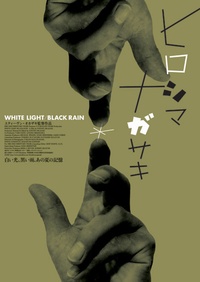
Not only Taniguchi, but the atomic bomb survivors in front of Okazaki seem to feel relaxed and open up to each other. This is partly because Okazaki has been in contact with them for 25 years, but also because he is neither Japanese nor white, and his neutrality allows them to open up and express their true feelings.
Another important part of this film is the testimony of four Americans who worked at the Los Alamos Atomic Bomb Laboratory and the crew of the Enola Gay, which dropped the atomic bomb. They all agree that dropping the atomic bomb was just a justification, since they had just carried out their mission. However, at the end, a navigator on the Enola Gay named Theodore Kirk says:
"Whenever a group of people get together, some idiot says, 'We should drop an atomic bomb on Iraq.' They have no idea what nuclear weapons are. If they did know, they wouldn't say that."
This one word that appears at the end of the movie makes me feel saved. Okazaki says he is not interested in movies with messages, but I think he wanted to convey this word of the pilot to both Americans and Japanese. The position of a Japanese American standing in the middle of the Pacific Ocean and watching the world unfold was successful in drawing out the true feelings of both the Japanese and the Americans.
As mentioned earlier, Okazaki also has another short 34-minute piece called "Mushroom Club." This work introduces the "Mushroom Society," which supports people with microcephaly caused by the atomic bomb, and it also features testimonies from atomic bomb survivors. Hiroshima city is known for its rivers, with several rivers running through the center. When the atomic bomb was dropped, many people, unable to bear the heat, jumped into the rivers and died. Saeki Toshiko, who was a newlywed at the time and was 25 years old, is now over 80 years old and still walks along the riverbanks, picking up buttons from junior high school students who were exposed to the bomb, buttons from firefighters, watches, rings, and other items.
"When the atomic bomb fell, many people were suffering, but I left everyone behind to search for my relatives. I thought I was a good person. But after the bomb fell, I did a lot of things in the town that I shouldn't have done."
As he speaks, tears well up in Saeki's eyes. Even now, he walks along the riverbank collecting belongings of the victims of the atomic bomb, as if he is making amends for that time.
A prayer-like sentiment for Hiroshima and Nagasaki
Born and raised in Venice, Los Angeles, Okazaki was in the Japanese-American Boy Scouts and attended a Japanese school on Saturdays. In elementary school, he spent all his time drawing. In middle school, he discovered the music of the Rolling Stones, became interested in rock music, and played guitar in a band. After graduating from high school, he moved to the Bay Area and majored in film at San Francisco State University, but continued to play in bands. His films occasionally feature scenes of young people engrossed in music, which is probably due to the feelings he had at the time. In both "Mushroom Club" and "Hiroshima, Nagasaki," the opening scene shows young people strumming guitars on the street. It's like a ritual before the story begins. Even in the main story, you sometimes realize how important music is to him. In "Days of Waiting," which depicts a Japanese-American internment camp during World War II, music using the sho was used to great effect.
Although documentaries depict facts, they are meant to be viewed by an audience, so it is better to have a certain degree of direction. In his case, the music he was into when he was young is utilized in a good way.
In addition to the atomic bomb and Japanese-American internment camps, Okazaki has also created works on a variety of themes, including Japanese pop culture, Native Hawaiian resident movements, American nuclear testing, drugs, and AIDS. Nevertheless, for him, Hiroshima and Nagasaki are like starting points and themes to which he always returns, even after leaving them for a time. He himself says that the reason is that there are no more disturbing and moving stories, but I feel that it is like a kind of "prayer." Otherwise, there would be no way he could have conducted such thorough interviews over such a long period of time.
There are probably many things he wants to write about, including those who are survivors of the atomic bombings abroad, such as those in Korea and China. His journey to Hiroshima and Nagasaki continues.
(Titles omitted)
Materials related to atomic bomb survivors in the United States
"The Heart of Atomic Bomb Victims in the United States" by Kazuo Soishi, Nagasaki Testimony, Vol. 9, 1977
"Were We the Enemy?" by Rinjiro Sodei, Ushio Publishing, 1978
"The Survivors" by Fuyuko Uesaka, Bungeishunju, 1989
"Fifty Years in the US: Me and the Atomic Bomb Victims in the US" by Kanji Kuramoto, Nippon Tosho Kankokai, 1999
"Hiroshima Testimony - Atomic Bomb Survivors Speak" Video Hiroshima Peace Culture Center 1986~
Testimony Video List (Foreigner Section)
No.1 Terada Francis Yoshiko
No.7 Emiko Ishimoto
No.8 Kanji Kuramoto
No.9 Saeki Hitori
No.17 Chieko Brave
No.33 Kazu Soishi
No.34 Chiyoko Naito
Director Steven Okazaki's production company, Farallon Films, website: http://farfilm.com/
*This article is a reprint of the second installment of the column series "From the Perspectives of Two Countries" in Renso Publishing 's online magazine "Kaze," which features information about new books, such as articles linking new books to current issues and daily topics, as well as monthly bestsellers and review columns of new books.
© 2009 Association Press and Tatsuya Sudo


